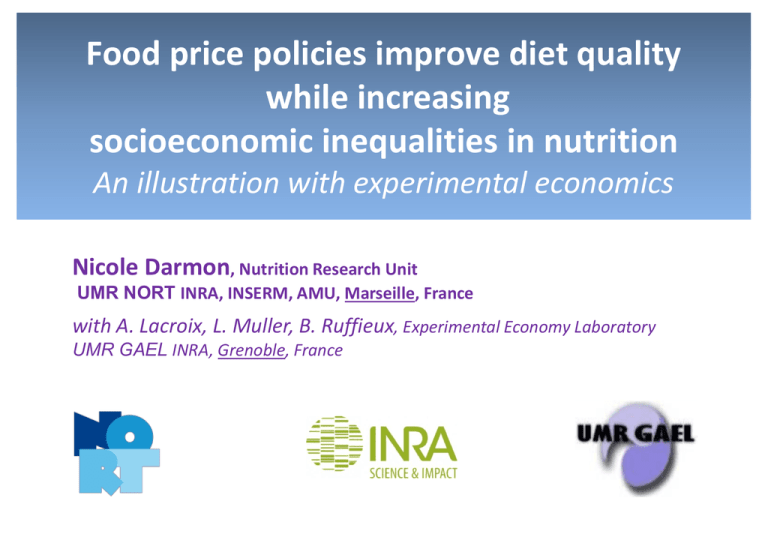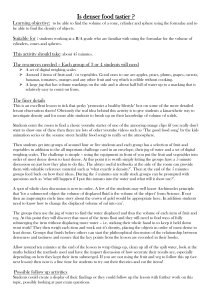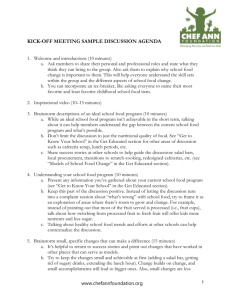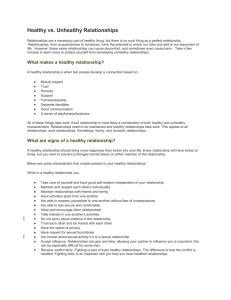Diapositiva 1
advertisement

Food price policies improve diet quality while increasing socioeconomic inequalities in nutrition An illustration with experimental economics Nicole Darmon, Nutrition Research Unit UMR NORT INRA, INSERM, AMU, Marseille, France with A. Lacroix, L. Muller, B. Ruffieux, Experimental Economy Laboratory UMR GAEL INRA, Grenoble, France Introduction: Social inequalities in diets and health, and cost constraints, in France Prevalence of adult obesity, by income, France 25 25,6 (Obepi survey, 2012) 22,8 % prevalence 20 19,4 18,8 16,2 15 16,1 15,3 11,9 10 8,8 7 5 0 <900 900-1200 1200-1500 1500-1900 1900-2300 2300-2700 2700-3000 3000-3800 > 3800- >5300 Household Income (€/month) Strong social gradient in obesity in France Link with food budget constraints? 1/20 INTRODUCTION Budget for food, by income, France (National budget survey, 2000) 25 22,5 20 17,5 15 12,5 10 7,5 5 D1 D2 D3 D4 D5 D6 D7 D8 D9 D10 Household income decile Double constraint: low amount of money weights heavily on total budget Impact on food choices? 2/20 INTRODUCTION Food consumption (g/d), by food sufficiency and income, France g/d 400 387g 351g (INCA2 survey, 2008) 336g 350 * Fruit & Vegetables 320g Means are adjusted on age, gender, and energy intakes 300 275g * 250 Starchy food Dairy products Mixed dishes, including soups Sweet products 200 * Meat/Fish/Poultry 150 F. Insecure FS1 FS2 FS3 FS4 (12%) Food secure, income quartiles Bocquier PHN 2015 Social gradient in diet quality Link with diet cost? 3/20 INTRODUCTION Diet cost (€/d), by quintiles of food group consumption, France €/d 8 7 6 5 4 Q1 Q2 Q3 Q4 Q5 Fruit and Vegetables Q1 Q2 Q3 Q4 Q5 Fats and sugar Drewnowski & Darmon AJPH 2004 Social gradient in diet quality Prices important determinants of food choices Link with food prices? 4/20 INTRODUCTION Energy Cost, €/100 kcal Cost of 100kcal from different food groups 0.66 € 0.7 0.58 € 0.6 Darmon, Nutr Rev, 2015 0.5 0.4 0.3 0.18 € 0.2 0.06 € 0.1 0.0 Fruit & Meat Vegetables & Fish Prepared dishes Dairy & Snacks Sugar/Salt Cereals products & Starches Added fats Healthy food groups are more expensive than unhealthy ones Unhealthy food groups are less expensive and more convenient (easy to transport, stock, prepare) 5/20 INTRODUCTION 100 Nutritional quality and price of individual food R² = 0,31 * SAIN/100g 10 1 0,1 *SAIN : mean adequacy for 15 nutrients N =687 food items 0,01 log 0,001 0,01 0,1 1 Price (€/100g) 10 100 Darmon, Nutr Rev, 2015 Healthy foods are more expensive than unhealthy ones The structure of food prices doesn’t favor healthy eating, possibly explaining: the socioeconomic gradient in diet quality, the higher prevalence of obesity in low-income populations 6/20 Hypothesis and Aim Hypothesis Food price policies (subsidies and taxes): may orient food choices towards more healthy options may help fighting against social inequalities in nutrition Aim Use experimental economics ? To simulate the impact of 2 policies: - subsidies - subsidies and taxes On the food choices of 2 populations: - medium-income women - low-income women 7/20 Methods Two policies 1. ‘Fruits & Vegetables (FV) policy’: 30% price reduction for fruit and vegetables (i.e. subsidies only) SAIN 2. ’Nutrient Profile (NP) policy’, 30% price reduction for healthy products 30% price increase for unhealthy products (i.e. both subsidies and taxes) F&V + other Healthy Intermediate Healthy and unhealthy products defined with the SAIN,LIM nutrient profile system: (Darmon N, Am J Clin Nutr 2009) Neutral Unhealthy LIM 8/20 Methods Two populations 1. Low-income group: 95 women below the poverty line, 18.5% were obese 2. Medium-income group: 33 women near the French median income 6.3% were obese. % prevalence Prevalence of adult obesity, by income <900 900-1200 1200-1500 1500-1900 1900-2300 2300-2700 2700-3000 3000-3800 > 3800- >5300 Household Income (€/month) 9/20 Methods Experimental economics 1. Subjects were asked to select (on a computer) daily food baskets that THEY WOULD LIKE TO BUY 2. They were told that THEY WOULD HAVE TO BUY one of the baskets (randomly selected) 3. At the end of the experiment, THEY REALLY BOUGHT one of the baskets they selected Incentive mechanism used to reveal ‘true’ preferences Limits the social desirability associated with purely declarative statements 10/20 Methods Experimental design - Description of one’s session task Learning Baseline F&V policy NP policy Task Yesterday Yesterday food basket Tomorrow Tomorrow food basket Tomorrow Tomorrow food basket Tomorrow Tomorrow food basket Prices No posted prices Market Market prices -30% -30% Fruit & Veg. -30% -30% Healthy Healthy foods +30% +30% Unhealthy Unhealthy foods Data collection Food purchased Expenditures Nutritional scores Food purchased Expenditures Expenditures Nutritional scores Food purchased Expenditures Expenditures Nutritional scores Food purchased Expenditures Nutritional scores Incentives Non-incited Incited Incited Incited Nutritional scores: Mean Adequacy Ratio (MAR), % adequacy/basket Energy Density (ED), in kcal/100g Free Sugars, % energy 11/20 Results Daily food baskets selected at baseline by the 2 populations Expenditure, in €/d Quantities, in g/d Medium Mediumincome income 1000 Lowincome income Low 800 600 400 * 2 1.2 * * * * 0.8 200 0.4 0 0 Fruit & Other Neutral Unhealthy Veg healthy * 1.6 Fruit & Other Neutral Veg healthy Unhealthy => Low income: more unhealthy products, less fruit&veg, less other healthy products, => Low income: also lower MAR, higher energy density, higher % energy from free sugars (not shown) At baseline, low-income women had less healthy diets 12/20 Results * Dietary changes (g/d) induced by the 2 prices policies in the 2 populations 1. Fruit & Veg policy 200 * Mediumincome income Medium 150 100 50 Low income Low income * 2. Nutrient Profile policy 200 150 100 * 50 * 0 0 -50 -50 -100 1 ** * Fruit & Other Neutral * Unhealthy Veg healthy => F&V purchases increased in both populations, but the magnitude was lower for the low-income => Medium- but not low-income women also increased other healthy products -100 * ** * Unhealthy Fruit & Other Neutral Veg healthy => F&V purchases increased and unhealthy products decreased in both populations => Medium- but not low-income women strongly increased other healthy products Results * Dietary changes (g/d) induced by the 2 prices policies in the 2 populations 1. Fruit & Veg policy 200 * Mediumincome income Medium 150 100 50 Low income Low income * 2. Nutrient Profile policy 200 150 100 * 50 * 0 0 -50 -50 -100 1 ** * Fruit & Other Neutral * Unhealthy Veg healthy -100 * ** * Unhealthy Fruit & Other Neutral Veg healthy Food policies had a favorable impact on food choices, but the magnitude of the effect was lower for the low income women 14/20 Results Nutritional quality at baseline and under the Fruit & Veg policy 1. MAR, %adequacy 14 Medium income Low income 160 65 3. Free sugars, % kcal 2. Energy Density, kcal/100g 12 140 60 120 10 100 8 80 6 55 50 Baseline F&V policy Baseline F&V policy Baseline F&V policy F&V policy improved nutritional quality in both populations, BUT the magnitude was lower in the low-income group Unwanted effects in the low-income group: free sugars increased Results Nutritional quality at baseline and under the Nutrient Profile policy 1. MAR, %adequacy 2. Energy Density, kcal/100g 14 Medium income Low income 160 65 3. Free sugars, % kcal 140 12 120 10 100 8 80 6 60 55 50 Baseline NP Policy Baseline NP Policy Baseline NP Policy The NP policy improved nutritional quality in both populations BUT the policy did not decrease nutritional inequalities (the low income group still had a lower nutritional quality than the medium income one) 16/20 Summary of results Fruit and Vegetables policy Fruit & Veg increased ------------------------- But lower magnitude for the low-income Other healthy foods increased------------- But in the medium-income group only Nutritional quality improved----------------- But unwanted effects for the low income Nutrient Profile policy Fruit & Veg increased-------------------------- Other healthy foods strongly increased Unhealthy products decreased------------ Nutritional quality improved----------------- Food price policies improved dietary quality But lower magnitude for the low-income But in the medium-income group only In both populations But lower magnitude for the low income BUT low income women benefited less than medium income women 17/20 Concluding remarks LIMITATIONS Small sample Experimental study Large (+/- 30%) variations in prices (unrealistic, politically unacceptable CONCLUSION Food price policies (subsidies and taxes): may orient food choices towards more healthy options but they may increase existing social inequalities in nutrition it is already known that policies directed at the whole population benefit more to the high income ones Study published International Journal of Behavorial Nutrition and Physical Activity, 2014 18/20 Concluding remarks Importance of targeting food policies at low income groups For instance: Facilitating the access to produce markets Develop urban community gardens in poor neighborhoods 19/20 Many thanks for you attention Additional results Increase of Social Disparities in purchasing power The purchasing power was improved for both groups by both policies, but inequalities increased between groups. The purchasing power of richer women was, relatively to the low incomes, improved because: - their initial consumption pattern generated more subsidies and fewer taxes -they better adapted the new price structure by opting for wished substitutions Suppl





